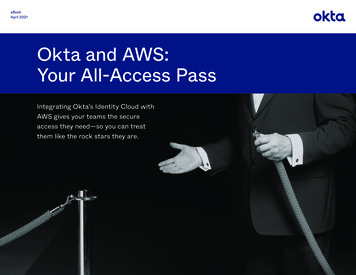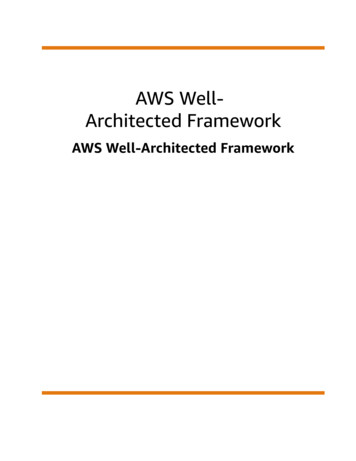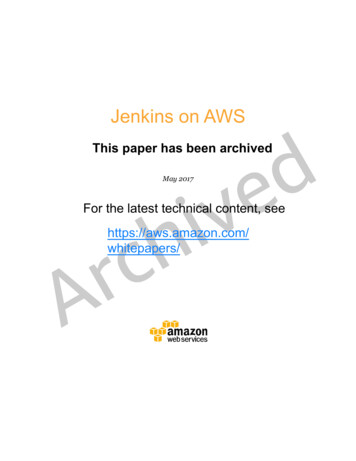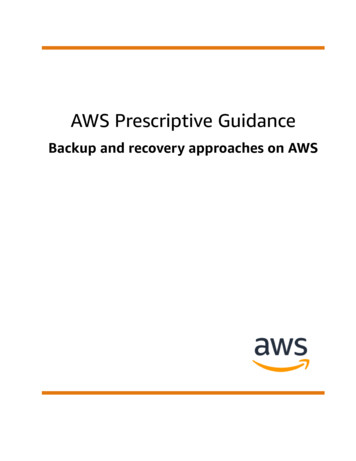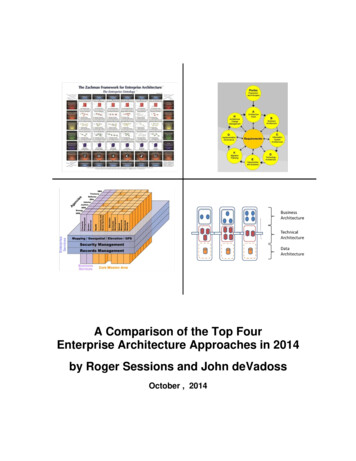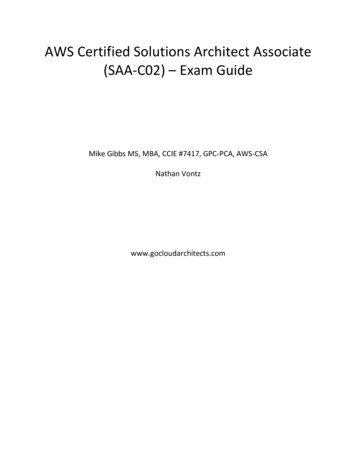
Transcription
AWS Certified Solutions Architect Associate(SAA-C02) – Exam GuideMike Gibbs MS, MBA, CCIE #7417, GPC-PCA, AWS-CSANathan Vontzwww.gocloudarchitects.com
AWS Certified Solutions Architect Associate (SAA-C02) – Exam Guide by MikeGibbs MS, MBA, CCIE #7417, GCP- PCA, AWS-CSA & Nathan VontzPort Saint Lucie, FL 34953www.gocloudarchitects.com 2021 Mike Gibbs & Nathan VontzAll rights reserved. No portion of this book may be reproduced in any formwithout permission from the publisher, except as permitted by U.S. copyright law.For permissions contact:elitetechcareers@gmail.com
DisclaimerLIABILITY: Mike Gibbs, Nathan Vontz, GoCloudArchitects and its organizations andagents specifically DISCLAIM LIABILITY FOR INCIDENTAL OR CONSEQUENTIALDAMAGES and assumes no responsibility or liability for any loss or damagesuffered by any person as a result of the use or misuse of our these materials orany of the information or content on our website, blogs and social media posts.Mike Gibbs, Nathan Vontz, GoCloudArchitects and its organizations and agentsassume or undertakes NO LIABILITY for any loss or damage suffered as a result ofthe use or misuse of any information or content or any reliance thereon.
Table of ContentsChapter 1 Introduction to Cloud ComputingThe History of the Enterprise Network and Data CenterConnections to the CloudHow to Access and Manage Resources in the Cloud1159Chapter 2 Storage Options on the AWS Cloud PlatformAWS Primary Storage OptionsAmazon Simple Storage Service (S3)Elastic Block Storage (EBS)Elastic File System (EFS)AWS Storage GatewayMigrating Data to AWSStorage for CollaborationAmazon FSx for Windows111112212425272828Chapter 3 Computing on the AWS Platform (EC2)Amazon Machine Images (AMI)AutoscalingInstance Purchasing OptionsTenancy OptionsSecuring EC2 AccessIP Addresses for EC2 InstancesAccessing EC2 Instances3132333335353737Chapter 4 Introduction to DatabasesRelational DatabasesDynamoDBData Warehousing on AWSDatabase Storage OptionsBacking Up the DatabaseScaling the DatabaseDesigning a High-Availability Database Architecture3946464849505155Chapter 5 The AWS Virtual Private CloudThe OSI ModelIP AddressingRouting Tables and RoutingInternet GatewaysNAT InstancesNAT GatewayElastic IP Addresses (EIPs)5858596568697071
EndpointsVPC PeeringAWS CloudHubNetwork Access Control Lists (NACL)Security Groups7274777980Chapter 6 AWS Network Performance OptimizationsPlacement GroupsAmazon Route 53Load Balancers83838689Chapter 7 SecurityAWS Shared Security ModelPrinciple of Least PrivilegeIndustry ComplianceIdentity and Access ManagementIdentity FederationsCreating IAM PoliciesFurther Securing IAM with Multifactor AuthenticationMulti-Account StrategiesPreventing Distributed Denial of Service AttacksAmazon Web Application Firewall (WAF)AWS ShieldAWS Service CatalogAWS Systems Manager Parameter Store9494969797102107111112114115116117118Chapter 8 AWS Applications and ServicesAWS Simple Queueing Service (SQS)AWS Simple Notification Service (SNS)AWS Simple Workflow Service (SWF)AWS KinesisAWS Elastic Container Service (ECS)AWS Elastic Kubernetes Service (EKS)AWS Elastic BeanstalkAWS CloudWatchAWS ConfigAWS CloudTrailAWS CloudFrontAWS LambdaAWS Lambda@EdgeAWS CloudFormationAWS Certificate Manager 148
Chapter 9 Cost OptimizationFinancial Differences Between Traditional Data Centers and Cloud ComputingOptimizing Technology Costs on the AWS CloudAWS BudgetsAWS Trusted Advisor150150150153154Chapter 10 Building High Availability ArchitecturesWhat is Availability?Building a High Availability Network156156156Chapter 11 Passing the AWS Exam160Chapter 12 Practice Exam162
Chapter 1Introduction to Cloud ComputingThe History of the Enterprise Network and Data CenterEver since computing resources provided a competitive advantage, organizations have beeninvesting in their computing resources. Over time technology became not only a competitiveadvantage but a necessary resource to be competitive in today’s business environment. Sincetechnology can bring extreme advances in productivity, sales, marketing, communication, andcollaboration, organizations invested more and more into technology. Organizations, therefore,built large and complex data centers, and connected those data centers to an organization’susers with specialized networking, security, and computing hardware resources. The enterprisedata center became huge networks, often requiring thousands of square feet of space,incredible amounts of power, cooling, hundreds, if not thousands, of servers, switches, routers,and many other technologies. Effectively, the enterprise and especially the global enterpriseenvironments became massive networks—just like a cloud computing environment. The netresult was a powerful private cloud environment.Global enterprise data centers and high-speed networks work well. However, these networkscome with a high cost and high level of expertise to manage these environments. Network anddata center technology is not simple, and it requires a significant staff of expensive employeesto design, operate, maintain, and fix these environments. Some large enterprise technologyenvironments take billions of dollars to create and operate.Global enterprise networks and data centers still have merit for high security, ultrahighperformance environments requiring millisecond-level latency, and ultrahigh network andcomputing performance. An example environment that benefits from this traditional model areglobal financial environments, where shaving milliseconds off network, server, and applicationperformance can equate to a significant competitive advantage. However, for many customers,the costs of procuring and operating the equipment are just too costly.Recent advances in network, virtualization, and processing power make the transition to thecloud computing feasible.Why Now Is the Optimal Time for Cloud ComputingLet’s first look at virtualization, as it is the key enabling technology of cloud computing. Serverperformance has increased dramatically in recent years. It is no longer necessary to have aserver or multiple servers for every application. Since today’s servers are so powerful, they can1
be partitioned into multiple logical servers in a physical server, reducing the need for so manyservers. This reduces space, power, and cooling requirements. Additionally, virtualizationmakes it simple to move, add, or change server environments. Previously, any time you wantedto make a server change, you had to buy a new server, which could take weeks or months,install the operating system and all the applications dependencies, and then find a time toupgrade the server when it wasn’t being used. This process was lengthy, as changes to any partof an IT environment can affect many other systems and users. With virtualization, to upgrade aserver you have to copy only the server file to another machine, and it’s up and running.Server virtualization became so critical in improving hardware resource utilization forcomputing, that soon organizations explored moving the network to virtualized servers. Nowrouting, firewalling, and many other functions can be shifted to virtualized services withsoftware-defined networking. For several years organizations have migrated their traditionaldatacenters to virtualized enterprise data centers, and it has worked well. However, networkspeed (bandwidth) has made such significant gains, while the cost of this high-performancenetworking has decreased substantially. Therefore, it is now possible to move the data centerto a cloud computing environment and still achieve high performance with lower total costs.With the ability to purchase multiple 10-gigabit-per-second links to AWS, it’s now feasible toconnect an organization to a cloud provider at almost the same speed as if the application is inthe local data center, but with the benefits of a cloud computing environment.Hybrid CloudA hybrid cloud combines a standard data center with outsourced cloud computing. For manyorganizations, the hybrid cloud is the perfect migration to the cloud. In a hybrid architecture,the organization can run its applications and systems in its local data center and offload part ofthe computing to the cloud. This provides an opportunity for the organization to leverage itsinvestment in its current technology while moving to the cloud. Hybrid clouds provide anopportunity to learn and develop the optimal cloud or hybrid architecture.Applications for hybrid cloud include: Disaster recovery – Run the organization computing locally, with a backup data center inthe cloud.On-demand capacity – Prepare for spikes in application traffic by routing extra traffic tothe cloud.High performance – Some applications benefit from the reduced latency and highernetwork capacity available on-premises, and all other applications can be migrated tothe cloud to reduce costs and increase flexibility.Specialized workloads – Move certain workflows to the cloud that require substantialdevelopment time, i.e., machine learning, rendering, transcoding.Backup – The cloud provides an excellent means to back up to a remote and securelocation.2
The diagram below shows an example of a hybrid cloud computing environment.Pure Cloud Computing EnvironmentIn a pure cloud computing environment, all computing resources are in the cloud. This meansservers, storage, applications, databases, and load balancers are all in the cloud. Theorganization is connected to the cloud with a direct connection or a VPN connection. The speedand reliability of the connection to the cloud provider will be the key determinant of theperformance of this environment.3
The diagram below shows an example of a pure cloud computing environment on the AWSplatform.A pure cloud computing environment has several advantages:Scalability – The cloud provides incredible scalability.Agility – Adding computing resources can occur in minutes versus weeks in a traditionalenvironment.Pay-as-you-go pricing – Instead of purchasing equipment for maximum capacity, which may beidle 90 percent of the time, exactly what is needed is purchased when needed. This can providetremendous savings.Professional management – Managing data centers is very complicated. Space, power, cooling,server management, database design, and many other components can easily overwhelm mostIT organizations. With the cloud, most of these are managed for you by highly skilledindividuals, which reduces the risk of configuration mistakes, security problems, and outages.Self-healing – Cloud computing can be set up with health checks that can remediate problemsbefore they have a significant effect on users.4
Enhanced security – Most cloud organizations provide a highly secure environment. Mostenterprises would not have access to this level of security due to the costs of the technologyand the individuals to manage it.Connections to the CloudIf an organization moves its computing environment to the cloud, then the connection to thecloud becomes critical. If the connection to the cloud fails, then the organization can no longeraccess cloud resources. The performance needs and an organization’s dependency on IT willdetermine the connection requirements to the cloud.For most organizations, getting a “direct” connection to the cloud will be the preferred method.A direct connection is analogous to a private line in the networking world because it iseffectively a wire that connects the organization to the cloud. This means guaranteedperformance, bandwidth, and latency. As long as the connection is available, performance isexcellent. This is unlike a VPN connection over the internet, where congestion anywhere on theinternet can negatively affect performance.Since network connections can fail, a direct connection is generally combined with a VPNbackup over the internet. A VPN can send the data securely over the internet to AWS. A VPNprovides data security via encryption and permits the transfer of routing information and theuse of private address space. VPNs work by creating an IP security (IPsec) tunnel over theinternet.5
The diagram below shows an example of a direct connection to the AWS platform.VPN Connection to AWSThe simplest and cheapest means to connect to AWS is a VPN. A VPN provides a means to“tunnel” traffic over the internet in a secure manner. Encryption is provided by IPsec, whichprovides a means to provide encryption (privacy), authentication (identifying of the user), dataauthenticity (meaning the data has not been changed), and non-repudiation (meaning, the usercan’t say they didn’t send the message after the fact). However, the problem with VPNconnections is that while the connection speed to the internet is guaranteed, there is nocontrol of what happens on the internet. So, there can be substantial performance degradationbased upon the availability, routing, and congestion on the internet. VPN-only connections areideal for remote workers and small branches of a few workers, where if they lose connectivity,there will not be significant costs to the organization.6
The diagram below shows an example of a VPN connecting to the AWS platform.7
High-Availability ConnectionsConnecting to the cloud with high availability is essential when an organization depends upontechnology.The highest availability architectures will include at least two direct connections to the cloud.Ideally, each connection is with a separate service provider, a dedicated router, and each routerconnected to different power sources. This configuration provides redundancy to the networkconnection, power failures, and the routers connecting to the cloud. For organizations thatneed 99.999 percent availability, this type of configuration is essential. For even higheravailability, there can be a VPN connection as a backup to the other direct connections.High Availability at Lower CostsA lower cost means to achieve high availability is to have a dedicated connection and a VPNbackup to the cloud. This will work well for most organizations, assuming they can toleratereduced performance when using the backup environment.8
Basic Architecture of the AWS CloudThe AWS cloud comprises multiple regions connected with the Amazon high-speed networkbackbone. Many regions exist, but to understand the topology, here is a simplified explanation.Think of a region as a substantial geographic space (a significant percentage of a continent).Now, each region has numerous data centers. Each data center within a region is classified asan availability zone. For high-availability purposes and to avoid single points of failure,applications and servers can be in multiple availability zones. Large global organizations canoptimize performance and availability by connecting to multiple regions with multipleavailability zones per region.How to Access and Manage Resources in the CloudThere are three ways to manage cloud computing resources on AWS. The methods to configureAWS cloud computing resources are the AWS Management Console, the Command LineInterface, and connecting via an API through the software development kit.AWS Management ConsoleThe AWS Management Console is a simple-to-use, browser-based method to manageconfigurations. There are numerous options, with guidance and help functions. Most users willuse the management console to set things up and perform basic system administration, whileperforming other system administration functions with the command line interface. You canaccess the management console at this URL. https://aws.amazon.com/console/AWS CLIThe AWS Command Line Interface enables you to manage computing resources via Linuxcommands and JavaScript Object Notation (JSON) scripting. This is efficient but requires moreknowledge, training, and organizations need to know exactly what is needed and how toconfigure properly. With the CLI, there is no guidance as in the AWS Management Console. Youwill access the CLI by using secure shell. If you’re using a Linux, Unix, or MacOS computer youcan access the secure shell from a terminal window. If your using windows, you will need toinstall an SSH application, one popular application is putty. You can download Putty at no costfrom this URL. https://www.putty.orgAWS SDKThe AWS Software Development Kit (SDK) provides a highly effective method to modify andprovision AWS resources on demand. This can be automated and can provide the ultimate9
scalability. This will require sophisticated knowledge to build the programming resources and isrecommended for experts.10
Chapter 2Storage Options on the AWS Cloud PlatformThere are several storage options available to AWS cloud computing customers. They are: AWSSimple Storage Service (S3), Elastic Block Storage, Elastic File System, Storage Gateways, andWorkDocs.In traditional data centers, there are two kinds of storage—block storage and file storage. Blockstorage is used to store data files on storage area networks (SANs) or cloud-based storageenvironments. It is excellent for computing situations where there is a need for fast, efficient,and reliable data transportation. File storage is stored on local systems, servers, or network filesystems.AWS Primary Storage OptionsIn the AWS cloud environment, there are three types of storage: block storage, object storage,and file storage.Block StorageBlock storage places data into blocks and then stores those blocks as separate pieces. Eachblock has a unique identifier. This type of storage places those blocks of data wherever it ismost efficient. This enables incredible scalability and works well with numerous operatingsystems.Object StorageObject-based storage differs from block storage. Object storage breaks data files into piecescalled objects. It then stores those objects in a single place that can be used by multiple systemsthat have network access to the storage. Since each object will have a unique ID, it’s easy forcomputing resources to access data on file-based storage. Additionally, each object hasmetadata or information about the data to make it easier to find when needed.File StorageFile storage is traditional storage. It can be used for a systems operating system and networkfile systems. Examples of this are NTFS-based volumes for Windows systems and NFS volumesfor Linux/UNIX systems. These volumes can be mounted and directly accessed by numerouscomputing resources simultaneously.11
AWS Object StorageThe AWS platform provides an efficient platform for block stage with Amazon Simple StorageService, otherwise known as S3.Amazon Simple Storage Service (S3)Amazon S3 provides high-security, high-availability, durable, and scalable object-based storage.S3 has 99.999999999 percent durability and 99.99 percent availability. Durability refers to a filegetting lost or deleted. Availability is the ability to access the system when you need access toyour data. So, this means data stored on S3 is highly likely to be available when you need it.Since S3 is object-based storage, it provides a perfect opportunity to store files, backups, andeven static website hosting. Computing systems cannot boot from object-based storage orblock-based storage. Therefore, S3 cannot be used for the computing platforms operatingsystem. Since block-based storage is effectively decoupled from the server’s operating system,it has near limitless storage capabilities. 1S3 is typically used for these applications: Backup and archival for an organization’s data.Static website hosting.Distribution of content, media, or software.Disaster recovery planning.Big data analytics.Internet application hosting.Amazon S3 is organized into buckets. Each bucket is a container for files stored on S3. Bucketscreate a top-level name space, meaning they must be globally unique and can be accessed bytheir DNS name. An example of this address can be seen ml12
The diagram below shows the organizational structure of S3.Since the buckets use DNS-type addressing, it is best to use names that follow standard DNSnaming conventions. Bucket names can have up to sixty-three characters including letters,numbers, hyphens, and periods. It’s noteworthy that the path you use to access the files on S3is not necessarily the location to where the file is stored. The URL used to access your file isreally a pointer to the database where your files are stored. S3 functions a lot like a databasebehind the scenes, which enables you do incredible things with data stored on S3 like SQLqueries. An organization can have up to 100 buckets per account without requesting a bucketlimit increase from AWS.Buckets are placed in different geographic regions. When creating the bucket, to achieve thehighest performance, place the bucket in a region that is closest. Additionally, this will decreasedata transfer changes across the AWS network. For global enterprises, it may be necessary toplace buckets in multiple geographic regions. AWS S3 provides a means for buckets to bereplicated automatically between regions. This is called cross-region replication.S3 Is Object-Based StorageS3 is used with many services within the AWS cloud platform. Files stored in S3 are calledobjects. AWS allows most objects to be stored in S3. Every object stored in an S3 bucket has a13
unique identifier, also known as a key. A key can be up to 1,024 bytes, which are comprised ofUnicode characters and can include slashes, backslashes, dots, and dashes.Single files can be as small as zero bytes, all the way to 5 TB per file. This provides ultimateflexibility. Objects in S3 can have metadata (information about the data), which can make S3extremely flexible and can assist with searching for data. The metadata is stored in a namevalue pair environment, much like a database. Since metadata is placed in a name-value pair, S3provides a SQL-based method to perform SQL-based queries of your data stored in S3. Topromote scalability, AWS S3 uses an eventually consistent system. While this promotesscalability, it is possible that after you delete an object, it may be available for a short period.Securing Data in S3The security of your data is paramount, and S3 storage is no exception. S3 is secured via thebuckets policy and user policies. Both methods are written in JSON access-based policylanguage.Bucket policies are generally the preferred method to secure your data in S3. Bucket policiesallow for granular control of the security of your digital assets stored in S3. Bucket policies arebased on IAM users and roles. S3 bucket policies are similar to the way Microsoft authenticatesusers and grants access to certain resources based upon the user’s role, permissions, andgroups in active directory. 2S3 also allows for using ACLs to secure your data. However, the control afforded to your datavia an ACL is much less sophisticated then IAM policies. ACL-based permissions are essentiallyread, write, or full control.The diagram below shows how ACL and bucket policies are used with AWS S3.14
S3 Storage TiersAWS S3 offers numerous storage classes to best suit an organization’s availability and financialrequirements. The main storage classes can be seen below: Amazon S3 StandardAmazon S3 Infrequent Access (Standard-IA)Amazon S3 Infrequent Access (Standard-IA) – One ZoneAmazon S3 Intelligent-TieringAmazon S3 GlacierAmazon S3 StandardAmazon S3 Standard provides high-availability, high-durability, high-performance, and lowlatency object storage. Given the performance of S3, it is well suited for storage of frequentlyaccessed data. For most general-purpose storage requirements, S3 is an excellent choice.Amazon S3 Infrequent Access (Standard-IA)Amazon S3 Infrequent Access provides the same high-availability, high-durability, highperformance, and low-latency object storage as standard S3. The major difference is the cost,which is substantially lower. However, with S3 Infrequent Access, you pay a retrieval fee everytime data is accessed. This makes S3 extremely cost-effective for long-term storage of data notfrequently accessed. However, access fees might make it cost-prohibitive for frequentlyaccessed data.Amazon S3 Infrequent Access (Standard-IA) – One ZoneAmazon S3 Infrequent Access provides the same service as Amazon S3-IA but with reduceddurability. This is great for backups of storage due to its low cost.Amazon S3 Intelligent TieringAmazon S3 Intelligent Tiering provides an excellent blend of S3 and S3-IA. Amazon keepsfrequently accessed data on S3 standard and effectively moves your infrequently accessed datato S3-IA. So, you have the best and most cost-effective access to your data.Amazon S3 GlacierAmazon Glacier offers secure, reliable, and very low-cost storage for data that does not requireinstant access. This storage class is perfect for data archival or backups. Access to data must berequested; after three to five hours the data becomes available. Data can be accessed soonerby paying for expedited retrievals. Glacier also has a feature called vault lock. Vault lock can beused for archives that require compliance controls, i.e., medical records. With vault lock, data15
cannot be modified but can be read when needed. Glacier, therefore, provides immutable dataaccess, meaning it can’t be changed while in Glacier.Managing Data in S3This next section describes how to manage and protect your data on S3.S3 Lifecycle ManagementThe storage tiers provided by S3 provide an excellent means to have robust access to data witha variety of pricing models. S3 lifecycle management provides an effective means toautomatically transition data to the best S3 tier for an organization’s storage needs.For example, let’s say you need access to your data every day for thirty days, then infrequentlyaccess your data for the next thirty days, and you may never access your data again but want tomaintain for archival purposes. You can set up a lifecycle policy to automatically move yourdata to the optimal location.You can store your data in S3, then after thirty days, have your data automatically moved to S3IA, and after thirty days, the data can be moved to Glacier for archival purposes. This can beseen in the diagram below.That’s the power of the lifecycle policies.Lifecycle policies can be configured to be attached to the budget or specific objects as specifiedby an S3 prefix.S3 VersioningTo help secure S3 data from accidental deletion, S3 versioning is the AWS solution.Amazon S3 versioning protects data against accidental or malicious deletion by keepingmultiple versions of each object in the bucket, identified by a unique version ID. Therefore,multiple copies of objects are stored in S3 when versioning is enabled. Every time there is achange to the object, S3 will store another version of that object. Versioning allows users to16
preserve, retrieve, and restore every version of every object stored in their Amazon S3 bucket.If a user makes an accidental change or even maliciously deletes an object in your S3 bucket,you can restore the object to its original state simply by referencing the version ID besides thebucket and object key. Versioning is turned on at the bucket level. Once enabled, versioningcannot be removed from a bucket; it can be suspended only.The diagram below shows how S3 versioning maintains a copy of all previous versions by usinga Key ID.Multifactor Authentication DeleteTo provide additional protection from data deletion, S3 supports multifactor authentication todelete an object from S3. When an attempt to delete an object from S3 is made, S3 will requestan authentication code. The authentication code will be a one-time password that changesevery few seconds. This one-time authentication code can be provided from a hardware keygenerator or a software-based authentication solution, i.e., Google Authenticator.Organizing Data in S3As previously discussed, S3 storage is very similar to a database. Essentially the data is stored asa flat arrangement in a bucket. While this scales well, it is not necessarily the most organizedstructure for end users. S3 allows the user to specify a prefix and delimiter parameter so theuser can organize their data in what feels like a folder. Essentially the user could use a slash / orbackslash \ as a delimiter. This will make S3 storage look and feel like a traditional Windows orLinux file system organized by folders.3 For example: namo.mp417
Encrypting Your DataS3 supports a variety of encryption methods to enhance the security of your data. Generally, alldata containing sensitive or organization proprietary data should be encrypted. Ideally, youencrypt your data on the way to S3, as well as when the data is stored (or resting) on S3. Asimple way to encrypt data on the way to S3 is to use https, which uses SSL to encrypt your dataon its way to the S3 bucket. Encrypting data on S3 can be performed using client-sideencryption or server-side encryption. 4,5Client-Side EncryptionClient-side encryption means encrypting the data files prior to sending to AWS. This means thefiles are already encrypted when transferred to S3 and will stay encrypted when stored on S3.To encrypt files using client-side encryption, there are two options available to use. Files can beencrypted with a client-side master key or a client master key using the AWS key managementsystem (KMS). When using client-side encryption, you maintain total control of the encryptionprocess, including the encryption keys.Server-Side EncryptionAlternatively, S3 supports server-side encryption. Server-side encryption is performed using S3and KMS. Amazon S3 automatically will encrypt when storing and decrypt when accessing yourdata on S3. There are several methods to perform server-side encryption and key management.These options are discussed below.SSE-KMS (
AWS Certified Solutions Architect Associate (SAA-C02) – Exam Guide Mike Gibbs MS, MBA, CCIE #7417, GPC-PCA, AWS-CSA Nathan Vontz www.gocloudarchitects.com




